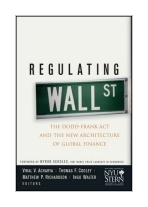|
||
podział tematyczny • wydawnictwa anglojęzyczne podział tematyczny Newsletter: • Zamów informacje o nowościach z wybranego tematu Informacje: • sposoby płatności i dostawy • kontakt • Cookies na stronie • Regulamin zakupów Napisz propresssp@gmail.com |
REGULATING WALL STREET: THE DODD-FRANK ACT AND THE NEW ARCHITECTURE OFACHARYA V.V. COOLEY T.F. RICHARDSON M.P. WALTER I./GLOBAL FINANCEwydawnictwo: WILEY , rok wydania 2010, wydanie Icena netto: net price + 5% vat. Experts from NYU Stern School of Business analyze new financial regulations and what they mean for the economy The NYU Stern School of Business is one of the top business schools in the world thanks to the leading academics, researchers, and provocative thinkers who call it home. In Regulating Wall Street: The New Architecture of Global Finance, an impressive group of the Stern school’s top authorities on finance combine their expertise in capital markets, risk management, banking, and derivatives to assess the strengths and weaknesses of new regulations in response to the recent global financial crisis.
The U.S. Congress is on track to complete the most significant changes in financial regulation since the 1930s. Regulating Wall Street: The New Architecture of Global Finance discusses the impact these news laws will have on the U.S. and global financial architecture. Table of Contents
Foreword. Preface. PROLOGUE: A BIRD'S-EYE VIEW. The Dodd-Frank Wall Street Reform and Consumer Protection Act (Viral V. Acharya, Thomas Cooley, Matthew Richardson, Richard Sylla, and Ingo Walter). PART ONE: Financial Architecture. CHAPTER 1: The Architecture of Financial Regulation (Thomas Cooley and Ingo Walter). CHAPTER 2: The Power of Central Banks and the Future of the Federal Reserve System (Thomas Cooley, Kermit Schoenholtz, George David Smith, Richard Sylla, and Paul Wachtel). CHAPTER 3: Consumer Finance Protection (Thomas Cooley, Xavier Gabaix, Samuel Lee, Thomas Mertens, Vicki Morwitz, Shelle Santana, Anjolein Schmeits, Stijn Van Nieuwerburgh, and Robert Whitelaw). PART TWO: Systemic Risk. CHAPTER 4: Measuring Systemic Risk (Viral V. Acharya, Christian Brownlees, Robert Engle, Farhang Farazmand, and Matthew Richardson). CHAPTER 5: Taxing Systemic Risk (Viral V. Acharya, Lasse Pedersen, Thomas Philippon, and Matthew Richardson). CHAPTER 6: Capital, Contingent Capital, and Liquidity Requirements (Viral V. Acharya, Nirupama Kulkarni, and Matthew Richardson). CHAPTER 7: Large Banks and the Volcker Rule (Matthew Richardson, Roy C. Smith, and Ingo Walter). CHAPTER 8: Resolution Authority (Viral V. Acharya, Barry Adler, Matthew Richardson, and Nouriel Roubini). CHAPTER 9: Systemic Risk and the Regulation of Insurance Companies (Viral V. Acharya, John Biggs, Hanh Le, Matthew Richardson, and Stephen Ryan). PART THREE: Shadow Banking. CHAPTER 10: Money Market Funds: How to Avoid Breaking the Buck (Marcin Kacperczyk and Philipp Schnabl). CHAPTER 11: The Repurchase Agreement (Repo) Market (Viral V. Acharya and T. Sabri Oncu). CHAPTER 12: Hedge Funds, Mutual Funds, and ETFs (Stephen Brown, Anthony Lynch, and Antti Petajisto). CHAPTER 13: Regulating OTC Derivatives (Viral V. Acharya, Or Shachar, and Marti Subrahmanyam0. PART FOUR: Credit Markets. CHAPTER 14: The Government-Sponsored Enterprises (Viral V. Acharya, T. Sabri Oncu, Matthew Richardson, Stijn Van Nieuwerburgh, and Lawrence J. White). CHAPTER 15: Regulation of Rating Agencies (Edward I. Altman, T. Sabri Oncu, Matthew Richardson, Anjolein Schmeits, and Lawrence J. White). CHAPTER 16: Securitization Reform (Matthew Richardson, Joshua Ronen, and Marti Subrahmanyam). PART FIVE: Corporate Control. CHAPTER 17: Reforming Compensation and Corporate Governance (Jennifer Carpenter, Thomas Cooley, and Ingo Walter). CHAPTER 18: Accounting and Financial Reform (Joshua Ronen and Stephen Ryan). Epilogue. About the Authors. About the Blog. Index. 573 pages, Hardcover Księgarnia nie działa. Nie odpowiadamy na pytania i nie realizujemy zamówien. Do odwolania !. |


